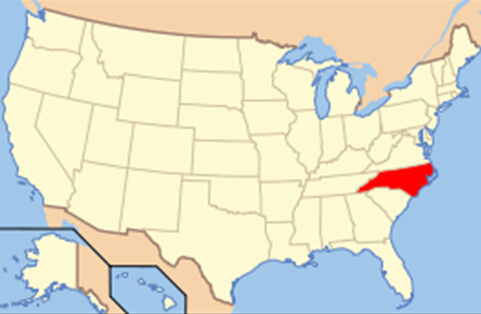

North Carolina is a state in Southeastern United States. The state borders South Carolina and Georgia to the south, Tennessee to the west, Virginia to the north, and the Atlantic Ocean to the east. North Carolina is the 28th most extensive and the 10th most populous of the 50 United States. North Carolina is known as the Tar Heel State and the Old North State.
North Carolina is composed of 100 counties. North Carolina's two largest metropolitan areas are among the top ten fastest growing in the country: its capital, Raleigh, and its largest city, Charlotte. In the past five decades, North Carolina's economy has undergone a transition from heavy reliance upon tobacco, textiles, and furniture making to a more diversified economy with engineering, energy, biotechnology, and finance sectors.
North Carolina has a wide range of elevations, from sea level on the coast to 6,684 feet (2,037 m) at Mount Mitchell, the highest point in the Eastern US. The climate of the coastal plains is strongly influenced by the Atlantic Ocean. Most of the state falls in the humid subtropical climate zone. More than 300 miles (500 km) from the coast, the western, mountainous part of the state has a subtropical highland climate.
Geography
North Carolina borders South Carolina on the south, Georgia on the southwest, Tennessee on the west, Virginia on the north, and the Atlantic Ocean on the east. The United States Census Bureau classifies North Carolina as a southern state in the subcategory of being one of the South Atlantic States.
North Carolina consists of three main geographic sections: the coastal plain, which occupies the eastern 45% of the state; the Piedmont region, which contains the middle 35%; and the Appalachian Mountains and foothills. The extreme eastern section of the state contains the Outer Banks, a string of sandy, narrow islands which form a barrier between the Atlantic Ocean and two inland waterways or "sounds": Albemarle Sound in the north and Pamlico Sound in the south. They are the two largest landlocked sounds in the United States. So many ships have been lost off Cape Hatteras that the area is known as the "Graveyard of the Atlantic". More than 1,000 ships have sunk in these waters since records began in 1526. The most famous of these is the Queen Anne's Revenge (flagship of the pirate Blackbeard) which went aground in Beaufort Inlet in 1718.
Immediately inland, the coastal plain is relatively flat, with rich soil ideal for growing tobacco, soybeans, melons, and cotton. The coastal plain is North Carolina's most rural section, with few large towns or cities. Agriculture remains an important industry.
The coastal plain transitions to the Piedmont region along the "fall line", a line which marks the elevation at which waterfalls first appear on streams and rivers. The Piedmont region of central North Carolina is the state's most urbanized and densely populated section. It consists of gently rolling countryside frequently broken by hills or low mountain ridges. Small, isolated, and deeply eroded mountain ranges and peaks are located in the Piedmont, including the Sauratown Mountains, Pilot Mountain, the Uwharrie Mountains, Crowder's Mountain, King's Pinnacle, the Brushy Mountains, and the South Mountains. The Piedmont ranges from about 300–400 feet (90–120 m) elevation in the east to over 1,000 feet (300 m) in the west. Due to the rapid population growth in the Piedmont, a significant part of the rural area in this region is being transformed into suburbs with shopping centers, housing, and corporate offices. Agriculture is steadily declining in its importance. The major rivers of the Piedmont, such as the Yadkin and Catawba, tend to be fast-flowing, shallow, and narrow.
The western section of the state is part of the Appalachian Mountain range. Among the subranges of the Appalachians located in the state are the Great Smoky Mountains, Blue Ridge Mountains, Great Balsam Mountains, and the Black Mountains. The Black Mountains are the highest in the Eastern United States, and culminate in Mount Mitchell at 6,684 feet (2,037 m). It is the highest point east of the Mississippi River. Although agriculture still remains important, tourism has become a dominant industry in the mountains. Growing Christmas trees has recently been an important industry. Due to the higher altitude, the climate in the mountains often differs markedly from the rest of the state. Winter in western North Carolina typically features high snowfall and subfreezing temperatures more akin to those of a midwestern state than of a southern state.
The first European settlement in North Carolina is the famous Lost Colony of Roanoke Island that vanished sometime after 1587. North Carolina is the northern portion of the original 1629 land grant made by England's King Charles I, which was named in his honor (Carolus is Latin for Charles). North Carolina joined the Union in 1789 and is the 12th of the original 13 states. One of its major industries is tourism, as many Americans travel to the state to enjoy its beautiful beaches. The capital of the "Tar Heel State" is Raleigh, and the dogwood blossom is the state flower.



















